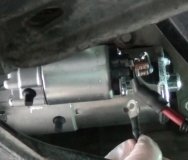You have to be connecting the battery cable terminal to the starter motor terminal, but only after your helper turns the ignition switch to "crank". "Crank" puts 12 volts on the solenoid terminal to make it engage physically.
You can do the same thing under the hood by connecting the solenoid terminal to the battery cable terminal. At that point you'll hear the loud clunk of the solenoid engaging. If the starter motor doesn't spin, the solenoid contacts are worn.
If you would have grounded the solenoid terminal by accident, the solenoid would have no idea that happened. There would be 0 volts on both sides of both coils of wire, so nothing would have happened. At worst, if that short was there while the ignition switch was in the "crank" position, you would have blown a fuse, arced the ignition switch's contacts, melted a wire, or, ... If a starter relay is used, you might have arced its contacts. The fact you're still using a helper make the solenoid engage proves it and its entire circuit are working fine.
If you had grounded the starter motor terminal when the solenoid was not engaged, nothing would happen. There's no voltage there at that time. If you had grounded the battery cable terminal at any time, you'd have had a huge shower of sparks. Often that melts the tool and welds it in place. A wrench will quickly turn orange and often bend from the excessive heat.
To know exactly what is happening, use a test light and measure on the solenoid terminal. You should see 0 volts, (test light is off), until your helper turns the ignition switch to "crank", then the light should be bright, and you'll hear the clunk as the solenoid engages. Next, test on the battery cable terminal. The light should be bright all the time, but when the system is working properly, it will dim a little during cranking.
The important measurement is at the starter motor terminal. You'll see 0 volts there at first. When the solenoid engages, you should see 10 - 11 volts. The test light will light up but slightly less than full brightness. If it does light up but the starter motor doesn't spin, it has worn brushes. That is not likely in this case because you wouldn't be able to get it to crank from under the hood or under any condition. If you do not see voltage at this time, the switching contacts inside the solenoid are worn, ... OR, ...
Since you've been fighting a loose nut somewhere, there could be an arced connection that is blocking current flow. The clue is found in where you take the voltage readings. Put the test light's probe right on the end of the threaded copper stud for the starter motor terminal, then turn the ignition switch to "crank". If you do find 12 volts there, move the probe from the stud to the metal terminal under the nut. (You're moving the probe less than 1/4"). Take another reading during cranking. If you find 0 volts there, that connection needs to be cleaned and tightened.
Image (Click to make bigger)
Monday, December 14th, 2015 AT 3:18 PM





